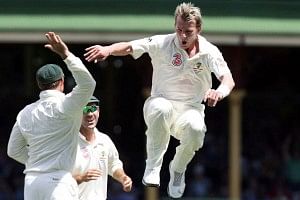
A tribute to Australia's lion-hearted warrior
The term ‘lion-hearted’ reminds me of very few cricketers – it’s not like your everyday average Joe can lay claim to the title on the back of just a couple of courageous performances here and there. One player who truly merits the tag, though, is the Australian pace machine who earlier today announced his retirement from international cricket – Brett Lee. Every single time that Lee has donned the Australian insignia on the field for the past 13 years, he has meant business. Whether it is his inexorable love for cricket or his monstrous appetite to play for Australia, he has been second to none.
 When a school kid shatters the stumps of 6 batsmen one after another in 6 deliveries, you know the kid has tremendous talent. Great cricketers have a mystic knack of recognizing talent, as did Steve Waugh. Having played with Brett Lee for New South Wales, he was awestruck by the sheer flair and capability of the lad, which made him call for Lee’s inclusion in the team. Eventually, Lee made his debut in the Boxing Day Test against India in 1999, and he did not disappoint – he dismissed opener Sadagoppan Ramesh off the fourth ball of his first over in Test cricket. That was the beginning of a fabled, awe-inspiring career that the then 23-year-old was about to script.
When a school kid shatters the stumps of 6 batsmen one after another in 6 deliveries, you know the kid has tremendous talent. Great cricketers have a mystic knack of recognizing talent, as did Steve Waugh. Having played with Brett Lee for New South Wales, he was awestruck by the sheer flair and capability of the lad, which made him call for Lee’s inclusion in the team. Eventually, Lee made his debut in the Boxing Day Test against India in 1999, and he did not disappoint – he dismissed opener Sadagoppan Ramesh off the fourth ball of his first over in Test cricket. That was the beginning of a fabled, awe-inspiring career that the then 23-year-old was about to script.
There was a time when hostile fast bowling was defined by greats like Lillee, Thomson and Sir Richard Hadlee, which was followed by the time when the likes of Akram, Donald and Ambrose dominated the scene. But in the modern era, it was Brett Lee alone who redefined contemporary fast bowling and its customary perception. He was the living, modern definition of fast bowling. There are very few things that can top the hostile exchange of words, aggression, passion and brutal intent that fast-bowlers possess in cricket; that nuance in the game for me is what makes the sport so exhilarating. When fast bowlers mark their run-up and charge towards the batsmen, a battle ensues – that is one battle Lee was a part of for 13 years. His ability to bowl at speeds of 150 and above – even aside from the fact that he did so consistently – was one of the most intimidating factors for batsmen all around the world.
In the 2002-03 Ashes, his spells manifested venom – he was vicious, hostile and daunting. He bowled with the same physiognomies in the 2003 World Cup. With Warne out of the reckoning, he along with Bichel and McGrath formed the most lethal triad in the tournament, bagging 59 wickets between them. The World Cup was also when Brett Lee reached the pinnacle of his bowling speed – he touched the 160 km/hr mark twice during the event. Adding to the accolades, he picked up the first hat-trick by an Australian in a World Cup, also the first hat-trick in T20 Internationals.
After the World Cup, Australia lost two of its most loyal and prized servants – Glenn McGrath and Shane Warne – following which, Lee rose to the occasion. The pressure on him to perform was tremendous, with a bunch of newbies who looked up to him; but he delivered, game after game. He led the bowling attack relentlessly, thriving under the pressure, until injuries started plaguing his career. But he continued to go out to the middle and bowl his heart out. Perhaps the strongest evidence of that are the repeated comebacks he made after injury – which by no means were less – having undergone a whopping 13 surgeries during his entire career. He always returned with a stronger will and a stronger desire to play for his country.
Brett Lee’s stellar career extended over 221 ODIs and 76 Tests for Australia. His final statement, which announced his decision to retire, said, “In a team environment you have to be committed 100%, both mentally and physically. Looking at the next two months, I just didn’t have that desire any more. It wouldn’t be fair on me or the rest of the team if I was to go over there with that attitude – not lack of commitment, but you just get to a point in your life when you decide enough is enough.” A statement that clearly reflects the way he approached the game throughout his career – with 100% commitment.

There are two things that can propel a player to push himself to reach greater heights – the desire to reach the zenith, and the determination to keep at it; Lee possessed both. A fierce competitor on the field and an affable comrade off it, Lee was well-liked not just by his teammates but also by his opponents. His sportsmanlike spirit was commended by the entire cricketing fraternity at various times. Despite being one wicket short of holding the record for the most number of wickets in ODIs for Australia, he will go down as one of the legends to have graced the game. He challenged his limits and raised the bar with every step he took, which makes him a truly inspiring figure.
Lee’s candid charm and humble bearing will be missed on the field. But more than that, a loyal servant of cricket who bled for his country, lost, achieved, laughed, cried, celebrated, mourned, defied all odds, set an example and inspired legions of people, will be missed. He was the lion who roared his way into millions of hearts.
The video clip below is just a tiny glimpse of what will be missed on the cricket field with Lee’s departure.